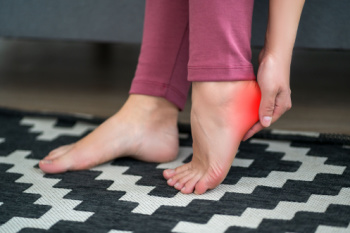
Heel spurs are bony growths that develop on the underside of the heel bone, often due to long-term strain on foot muscles and ligaments. They are commonly associated with plantar fasciitis, a condition that causes inflammation of the band of tissue connecting the heel to the toes. People who run frequently, wear unsupportive shoes, or have flat feet or high arches are more likely to develop heel spurs. Symptoms include sharp, stabbing pain in the heel, especially with the first steps in the morning or after long periods of rest. The pain often eases with movement, but may return after standing or walking for extended periods of time. A podiatrist can diagnose heel spurs using a physical exam and imaging such as X-rays. Treatment includes custom orthotics, targeted exercises, or anti-inflammatory medications. In rare cases, surgery may be recommended. If you have heel pain, it is suggested that you schedule an appointment with a podiatrist who can accurately diagnose and treat heel spurs.
Heel spurs can be incredibly painful and sometimes may make you unable to participate in physical activities. To get medical care for your heel spurs, contact one of our podiatrists from Prince William Foot & Ankle Center, PC. Our practitioners will do everything possible to treat your condition.
Heels Spurs
Heel spurs are formed by calcium deposits on the back of the foot where the heel is. This can also be caused by small fragments of bone breaking off one section of the foot, attaching onto the back of the foot. Heel spurs can also be bone growth on the back of the foot and may grow in the direction of the arch of the foot.
Older individuals usually suffer from heel spurs and pain sometimes intensifies with age. One of the main condition's spurs are related to is plantar fasciitis.
Pain
The pain associated with spurs is often because of weight placed on the feet. When someone is walking, their entire weight is concentrated on the feet. Bone spurs then have the tendency to affect other bones and tissues around the foot. As the pain continues, the feet will become tender and sensitive over time.
Treatments
There are many ways to treat heel spurs. If one is suffering from heel spurs in conjunction with pain, there are several methods for healing. Medication, surgery, and herbal care are some options.
If you have any questions, please feel free to contact our offices located in Gainesville and Dulles, VA . We offer the newest diagnostic and treatment technologies for all your foot care needs.
